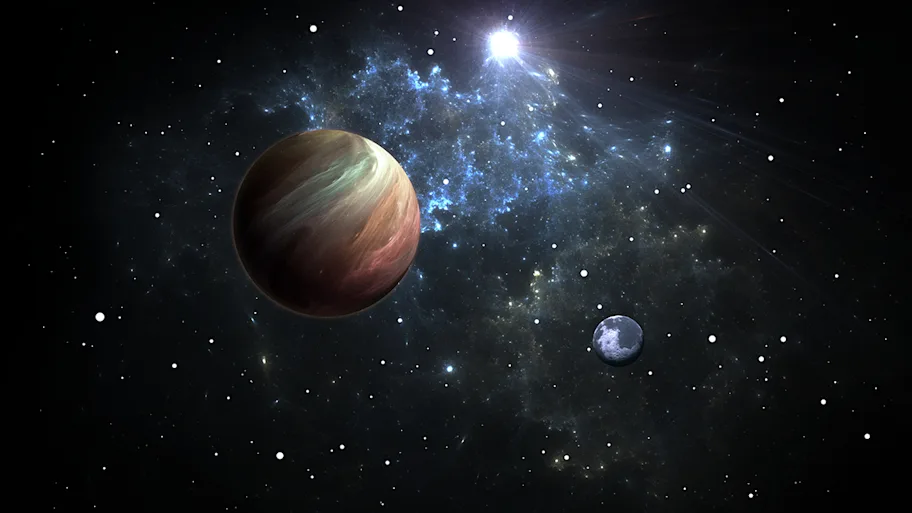
- Science News
- Featured news
- Researchers identify five double star systems potentially suitable for life
Researchers identify five double star systems potentially suitable for life
By Mischa Dijkstra, Frontiers science writer

Credit: 213688585 / Shutterstock.com
New mathematical framework predicts that systems Kepler-34, -35, -38, -64 and -413 with circumbinary giant planets have stable Habitable Zones
Almost half a century ago, the creators of Star Wars imagined a life-sustaining planet, Tatooine, orbiting a pair of stars. Now, scientists have found new evidence that five known systems with multiple stars, Kepler-34, -35, -38, -64 and -413, are possible candidates for supporting life.
A newly developed mathematical framework allowed researchers at New York University Abu Dhabi and the University of Washington to show that those systems – between 2,764 and 5,933 light years from Earth, in the constellations Lyra and Cygnus – support a permanent ‘Habitable Zone’, a region around stars in which liquid water could persist on the surface of any as-yet undiscovered Earth-like planets. Of these systems, Kepler-64 is known to have at least four stars orbiting one another at its center, while the others have two stars.
All are known to have at least one giant planet the size of Neptune or greater. This study, published in Frontiers in Astronomy and Space Sciences, is proof-of-principle that the presence of giant planets in binary systems does not preclude the existence of potentially life-supporting worlds.
“Life is far most likely to evolve on planets located within their system’s Habitable Zone, just like Earth. Here we investigate whether a Habitable Zone exists within nine known systems with two or more stars orbited by giant planets. We show for the first time that Kepler-34, -35, -64, -413 and especially Kepler-38 are suitable for hosting Earth-like worlds with oceans,” says corresponding author Dr Nikolaos Georgakarakos, a research associate from the Division of Science at New York University Abu Dhabi.
Download original article (pdf)
The scientific consensus is that the majority of stars host planets. Ever since 1992, exoplanets have been discovered at an accelerating pace: 4,375 have been confirmed so far, of which 2,662 were first detected by NASA’s Kepler space telescope during its 2009-2018 mission to survey the Milky Way. Further exoplanets have been found by NASA’s TESS telescope and missions from other agencies, while the European Space Agency is due to launch its PLATO spacecraft to search for exoplanets by 2026.
Twin stars and giant planets pose special conditions on life
12 of the exoplanets discovered by Kepler are ‘circumbinary’, that is, orbiting a close pair of stars. Binary systems are common, estimated to represent between half and three quarters of all star systems. So far, only giant exoplanets have been discovered in binary systems, but it is likely that smaller Earth-like planets and moons have simply escaped detection.
Gravitational interactions within multi-star systems, especially if they contain other large bodies such as giant planets, are expected to make conditions more hostile to the origin and survival of life. For example, planets might crash into the stars or escape from orbit, while those Earth-like exoplanets that survive will develop elliptical orbits, experiencing strong cyclical changes in the intensity and spectrum of radiation.
“We’ve known for a while that binary star systems without giant planets have the potential to harbor habitable worlds. What we have shown here is that in a large fraction of those systems Earth-like planets can remain habitable even in the presence of giant planets,“ says co-author Prof Ian Dobbs-Dixon, also at New York University Abu Dhabi.
Georgakarakos et al here build on previous research to predict the existence, location, and extent of the permanent habitable zone in binary systems with giant planets. They first derive equations that take into account the class, mass, luminosity, and spectral energy distribution of the stars, combined with the added gravitational effect of the giant planet. Also considered are the eccentricity (ie degree of ellipticity of the orbit), semi-major axis, and period of the hypothetical Earth-like planet’s orbit, plus the dynamics of the intensity and spectrum of the stellar radiation that falls upon its atmosphere. Another factor is the Earth-like planet's ‘climate inertia’, that is, the speed at which the atmosphere responds to changes in irradiation.
They then look at nine known binary star systems with giant planets, all discovered by the Kepler telescope, to determine whether Habitable Zones exist in them and are ‘quiet enough’ to harbor potentially life sustaining worlds.
The authors show for the first time that permanent habitable zones exist in Kepler-34, -35, -38, -64, and -413. Those zones are between 0.4-1.5 Astronomical Units (au) wide beginning at distances between 0.6-2 au from the center of mass of the binary stars.
Not all systems with circumbinary giant planets are suitable
“In contrast the extent of the habitable zones in two further binary systems, Kepler-453 and -1661, is roughly half the expected size, because the giant planets in those systems would destabilize the orbits of additional habitable worlds. For the same reason Kepler-16 and -1647 cannot host additional habitable planets at all. Of course, there is the possibility that life exists outside the habitable zone or on moons orbiting the giant planets themselves, but that may be less desirable real-estate for us,” says coauthor Dr Siegfried Eggl at the University of Washington.
“Our best candidate for hosting a world that is potentially habitable is the binary system Kepler-38, approximately 3,970 light years from Earth, and known to contain a Neptune-sized planet,” says Georgakarakos.
“Our study confirms that even binary star systems with giant planets are hot targets in the search for Earth 2.0. Watch out Tatooine, we are coming!”
REPUBLISHING GUIDELINES: Open access and sharing research is part of Frontiers’ mission. Unless otherwise noted, you can republish articles posted in the Frontiers news blog — as long as you include a link back to the original research. Selling the articles is not allowed.






